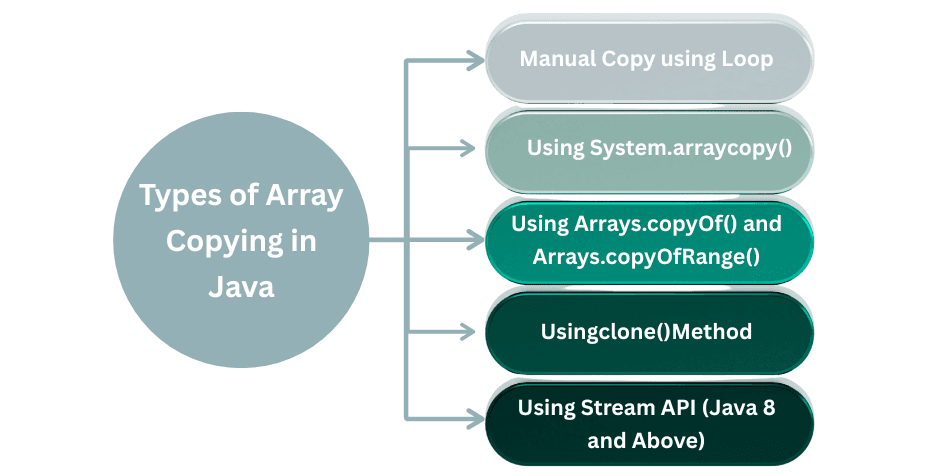Copying Arrays in Java
In Java, arrays are fixed in size, and sometimes you need to create a copy of an existing array — either fully or partially.
There are multiple ways to copy arrays in Java, ranging from manual loops to built-in methods like System.arraycopy(), Arrays.copyOf(), and Arrays.copyOfRange().
Java provides multiple ways to copy arrays — from simple loops to advanced built-in methods.
Types of Array Copying in Java

1. Manual Copy using Loop
You can copy elements one by one using a for or for-each loop.
public class ManualCopyExample {
public static void main(String[] args) {
int[] original = {10, 20, 30, 40, 50};
int[] copy = new int[original.length];
for (int i = 0; i < original.length; i++) {
copy[i] = original[i];
}
System.out.print("Copied Array: ");
for (int n : copy)
System.out.print(n + " ");
}
}
Output:
Copied Array: 10 20 30 40 50
Points to remember:
- Easy to understand and beginner-friendly.
- Works with both primitive and object arrays.
- Slower for large arrays.
2. Using System.arraycopy()
The fastest and most efficient way to copy arrays in Java.
public class SystemArrayCopyExample {
public static void main(String[] args) {
int[] original = {1, 2, 3, 4, 5};
int[] copy = new int[original.length];
System.arraycopy(original, 0, copy, 0, original.length);
System.out.print("Copied Array: ");
for (int n : copy)
System.out.print(n + " ");
}
}
Output:
Copied Array: 1 2 3 4 5
Points to remember:
- Performs shallow copy (copies references for objects).
- Very fast, suitable for performance-critical code.
- Used internally by Java libraries.
3. Using Arrays.copyOf() and Arrays.copyOfRange()
Java’s java.util.Arrays class provides two useful methods for copying arrays.
Example 1 – Arrays.copyOf()
import java.util.Arrays;
public class CopyOfExample {
public static void main(String[] args) {
int[] original = {10, 20, 30, 40, 50};
int[] copy = Arrays.copyOf(original, original.length);
System.out.println("Copied Array: " + Arrays.toString(copy));
}
}
Output:
Copied Array: [10, 20, 30, 40, 50]
Example 2 – Arrays.copyOfRange()
import java.util.Arrays;
public class CopyOfRangeExample {
public static void main(String[] args) {
int[] original = {10, 20, 30, 40, 50};
int[] subArray = Arrays.copyOfRange(original, 1, 4);
System.out.println("Copied Range: " + Arrays.toString(subArray));
}
}
Output:
Copied Range: [20, 30, 40]
Points to remember:
- Creates a new array — doesn’t modify the original.
- Ideal for resizing or partial copying.
- Returns a copy with the specified length or range.
4. Using clone() Method
Every array in Java has a clone() method to make a copy.
public class CloneArrayExample {
public static void main(String[] args) {
int[] original = {5, 10, 15, 20};
int[] copy = original.clone();
System.out.println("Original Array: " + java.util.Arrays.toString(original));
System.out.println("Cloned Array: " + java.util.Arrays.toString(copy));
}
}
Output:
Original Array: [5, 10, 15, 20]
Cloned Array: [5, 10, 15, 20]
Points to remember:
- Creates a shallow copy.
- For primitive arrays, it behaves like deep copy.
- For object arrays, only references are copied.
5. Using Stream API (Java 8 and Above)
Java 8 Streams offer a functional way to copy or filter arrays.
import java.util.Arrays;
public class StreamCopyExample {
public static void main(String[] args) {
int[] original = {3, 6, 9, 12, 15};
int[] copy = Arrays.stream(original).toArray();
System.out.println("Copied Array: " + Arrays.toString(copy));
}
}
Output:
Copied Array: [3, 6, 9, 12, 15]
Points to remember:
- Modern and clean approach using Streams.
- Great for filtering, mapping, or transforming while copying.
- Slightly slower than
System.arraycopy()for large arrays.
Which Method Should You Use?
| Method | Best Use Case | Performance |
|---|---|---|
| Manual Loop | Small arrays or beginners | Slow |
System.arraycopy() | High-speed copying | Fastest |
Arrays.copyOf() / copyOfRange() | Resizing / range copy | Efficient |
clone() | Simple shallow copy | Moderate |
| Stream API | Functional programming | Slightly slower |
🏆 Top 5 Interview Questions – Copying Arrays in Java
1. What is the difference between shallow copy and deep copy in arrays?
Answer:
| Copy Type | Description | Example Use |
|---|---|---|
| Shallow Copy | Copies only references (not actual objects) — changes in one affect the other. | Object arrays |
| Deep Copy | Creates a new copy of actual data — both arrays are independent. | Primitive type arrays or cloned custom objects |
Example:
int[] a = {1, 2, 3};
int[] b = a; // Shallow copy (both point to same memory)
2. Which is the fastest method to copy arrays in Java?
Answer: System.arraycopy() is the fastest because it uses native (low-level) system code for memory copying.
It’s highly optimized and used internally by Java for performance-critical operations.
3. What is the difference between clone() and Arrays.copyOf()?
Answer:
| Feature | clone() | Arrays.copyOf() |
|---|---|---|
| Return Type | Returns the same type of array | You can specify new length |
| Range Support | Copies full array only | Can copy partially |
| Null Safety | Can throw NullPointerException | Handles safely |
| Customization | Limited | Flexible resizing and range selection |
4. How can you copy only a part (range) of an array in Java?
Answer: You can use Arrays.copyOfRange(original, from, to).
Example:
int[] arr = {10, 20, 30, 40, 50};
int[] sub = Arrays.copyOfRange(arr, 1, 4);
System.out.println(Arrays.toString(sub));
Output:
[20, 30, 40]
5. What happens when you clone an array of objects?
Answer: When you clone an object array, Java performs a shallow copy — it copies only references, not the actual objects.
That means changing an object inside the cloned array also affects the original.
Example:
String[] names = {"A", "B"};
String[] copy = names.clone();
copy[0] = "Z";
System.out.println(names[0]); // Output: "Z"
To achieve deep copy, you must manually clone each element.

